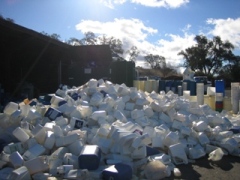Nearly twenty years ago I was on a cross Canada road trip and I had become accustomed enough to the sight of stacks of jugs near prairie dumps that I no longer remarked on it. On this  occasion I was traveling with a companion and she asked me why huge snow drifts of white plastic jugs, all of uniform size and bearing identical labels were stacked at the dump. I told her about the recycling and toxic waste project which meant the jugs could not merely be dumped but something about my trite explanation rankled, even with me.
occasion I was traveling with a companion and she asked me why huge snow drifts of white plastic jugs, all of uniform size and bearing identical labels were stacked at the dump. I told her about the recycling and toxic waste project which meant the jugs could not merely be dumped but something about my trite explanation rankled, even with me.
On subsequent trips I noticed the jugs more. Nearly every small town had stack big enough that it would dwarf a regular sized  factory swine barn. They were stacked neatly and away from the smouldering pit where the householder dumped their waste. I thought about all the household waste that we pitch into a dump without a thought about it toxicity, such as batteries and electronics, and the piles of jugs made even less sense. Why do we set them aside, I began to wonder.
factory swine barn. They were stacked neatly and away from the smouldering pit where the householder dumped their waste. I thought about all the household waste that we pitch into a dump without a thought about it toxicity, such as batteries and electronics, and the piles of jugs made even less sense. Why do we set them aside, I began to wonder.
Perhaps, I thought at first, it is the merely amount of them. They bulked much larger than any of the other waste the locals produced, so perhaps in our economy of scale that meant transporting them to a recycling station was worthwhile. Then I remembered their toxicity. The plastic itself that makes up the  jugs is not toxic, or at least is no more toxic than any of our other plastics. They all leach questionable toxins into the environment but not on the scale of the toxins from the farm jugs.
jugs is not toxic, or at least is no more toxic than any of our other plastics. They all leach questionable toxins into the environment but not on the scale of the toxins from the farm jugs.
The jugs are toxic waste because the chemicals they contain are so harmful to the environment, or people and other animals they cannot merely be piled on the farm. They need to be disposed of properly.
But how much of the herbicide or pesticide would a farmer leave in a jug? Any farmer concerned with his profits and brought up to be parsimonious, would use every drop. Only a tablespoon or so might still lie in the bottom of the jug if the farmer had to pay for the poison to begin with. So the jug that transported a hundred litres of poison has to be disposed of carefully because of a tablespoon of poison that might remain in the bottom. Many of the recyclers specify that all pesticide containers have to be triple rinsed and have instructions on how to do that. That stuff has to be pretty toxic.
I used to tell my students this story when we talked about the safety of modern agricultural methods. Most of them were aware of phosphates and nitrogen drained from fertilizers we’d put on the fields and going into the water supplies so that algae bloomed from the extra dose of nutrient and local life suffered from the subsequent lack of oxygen. They knew of similar problems with effluent from swine and chicken factory farms. They also knew that herbicide and pesticide use is a huge industry that makes billions of dollars preventing pests from eating our food or plants from competing with the nutrient our food needs.
What they didn’t know, or at least think about too much, was how toxic we knew the poisons to be. Winnipeg is a city where they “fog” for mosquitoes, and nearly any humid summer evening, if you are out late, or up early for a jog like my friend, you might get sprayed with a dozen or so poisons designed to kill the many mosquitoes that breed in the ponds and brooks that crisscross the city. The notion of toxins isn’t alien to my students’ thinking.
What they had never considered, just as I had never thought about it, was how toxic must the poisons be if we must carefully dispose of a jug just because a small amount of the substance is left in the bottom. The implications of that would come to light when I asked them, “Did you ever ask yourself what we did with the rest of the contents of the jug? That’s right, we sprayed it on our food.” As I said to them many times after relating my gradual awakening about the use of pesticides and herbicides, “As far as I’m concerned you might as well as throw that jug in the river.” We sprayed the rest of it on our food and all over our land and then suddenly we become shy about the tablespoon of poison in the bottom of the bottle.
Like many of life’s lessons, the answer is always before us. We might forget how toxic the poison is when we spray it onto our food, but we should make the association when we carefully stack our jug with a hundred thousand others so that it might be safely disposed of.
